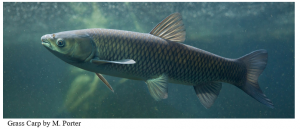Everyone tends to think of goldfish as these small innocent fish that everyone and their brother has as a pet when they are growing up but most do not know that when they are released into larger waterways that they grow to enormous sizes. I recently read an article that highlights Cleveland Metro Parks and their battle against these goldfish in their waterways  (Johnston, 2017). The representatives from the Metro Parks speak about how these goldfish can be found all over their waterways and cause problems for native species. This is accurate with the idea that non-native introduced species like these goldfish take away resources for the native species (Nico et al., 2013). The Cleveland Metro Parks are especially unhappy with the goldfish being there because they tend to take the resources away from the pan fish and catfish and they reproduce very quickly. Metro parks uses electrofishers to stun and then capture the fish for removal which is a very selective removal technique meaning that it can be used to collect the goldfish and leave the other fish alone.
(Johnston, 2017). The representatives from the Metro Parks speak about how these goldfish can be found all over their waterways and cause problems for native species. This is accurate with the idea that non-native introduced species like these goldfish take away resources for the native species (Nico et al., 2013). The Cleveland Metro Parks are especially unhappy with the goldfish being there because they tend to take the resources away from the pan fish and catfish and they reproduce very quickly. Metro parks uses electrofishers to stun and then capture the fish for removal which is a very selective removal technique meaning that it can be used to collect the goldfish and leave the other fish alone.
This whole situation is a prime example of what happens when people release their pets into native waterways. They do not always become this invasive or detrimental to the other species but when they do it becomes something that could have been easily avoided. The lesson to be learned from this situation is that you should never release your pets into the wild because you never know what effect they can have on the native species.
Sources:
- Johnston, C. L. (2017, October 26). Monster goldfish: What happens when you release that little pet into the wild. Retrieved October 31, 2017, from http://www.cleveland.com/metro/index.ssf/2017/10/monster_goldfish_what_happens.html
- Lennox, S. (2016, April 9). Giant Goldfish Are Invading Alberta Waters: Reports. Retrieved October 31, 2017, from http://www.ecanadanow.com/science/2016/04/09/giant-goldfish-are-invading-alberta-waters/ (Pictures)
- Nico, L.G., P.J. Schofield, J. Larson, T.H. Makled, and A. Fusaro, Carassius auratus(Linnaeus, 1758): U.S. Geological Survey, Nonindigenous Aquatic Species Database, Gainesville, FL, https://nas.er.usgs.gov/queries/factsheet.aspx?SpeciesID=508, Revision Date: 8/2/2013, Access Date: 10/31/2017


